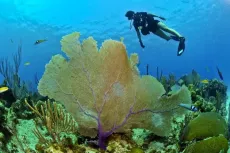Mysterious Lives in the Deep Ocean
The deep ocean, often referred to as the "final frontier," remains one of the most enigmatic and least explored areas of our planet. Stretching beyond the reach of sunlight, this dark abyss is home to a plethora of extraordinary creatures, each uniquely adapted to survive in one of Earth's most extreme environments. From bioluminescence to remarkable survival strategies, the denizens of the deep ocean offer a glimpse into the astonishing capabilities of evolutionary adaptation.
The Realm of Darkness
Descending into the deep ocean means entering a world devoid of natural light, where the sun's rays can't penetrate. This zone is characterized by crushing pressures, near-freezing temperatures, and a complete absence of daylight. These conditions create a unique set of challenges for the creatures that inhabit this mysterious realm. To thrive in such an environment, deep-sea organisms have evolved a range of extraordinary adaptations.
Phosphorescence and Bioluminescence
One of the most captivating features of deep-sea life is the phenomenon of bioluminescence, often manifesting as phosphorescence. Bioluminescence is the production and emission of light by living organisms, a trait that has evolved independently in various deep-sea species. This natural light is produced through a chemical reaction between a light-emitting pigment called luciferin and an enzyme called luciferase.
In the pitch-black waters of the deep ocean, bioluminescence serves several crucial functions. One of its primary uses is for communication. Many species employ light displays to attract mates, signal distress, or establish territory. For instance, the Lanternfish, one of the most abundant deep-sea fish, has light-emitting organs called photophores along its body. These photophores can be turned on or off to create patterns of light that help the fish communicate and navigate in the dark.
Another fascinating example of bioluminescence is seen in the anglerfish. This predatory fish has a bioluminescent lure, a modified dorsal fin spine with a light-producing organ at the tip. The anglerfish uses this lure to attract unsuspecting prey within striking distance. The glow of the lure contrasts starkly with the darkness of the deep, making it an effective trap for catching food.
Evolutionary Adaptations to Extreme Environments
Survival in the deep ocean requires a suite of specialized adaptations. These adaptations can be broadly categorized into structural, physiological, and behavioral strategies.
Structural Adaptations
Many deep-sea creatures possess large, sensitive eyes adapted to detect the faintest glimmers of light. For example, the giant squid has enormous eyes that can be up to 10 inches in diameter, enabling it to see in the near-total darkness of the deep sea. These large eyes are believed to enhance their ability to spot predators and prey in the dim conditions of their habitat.
Another structural adaptation is the reduction of body size in many deep-sea species, a phenomenon known as "dwarfism." This is particularly evident in deep-sea crustaceans like the deep-sea shrimp. Smaller body sizes reduce metabolic rates, which is advantageous in an environment where food is scarce.
Physiological Adaptations
The high-pressure environment of the deep ocean poses a significant challenge to living organisms. Many deep-sea creatures have evolved flexible, gelatinous bodies to withstand the immense pressure. The deep-sea jellyfish, for instance, has a largely transparent, gelatinous body that helps it survive under extreme pressure.
Additionally, deep-sea organisms often have specialized enzymes and proteins that function optimally under high pressure. These adaptations allow them to maintain metabolic processes and structural integrity in an environment that would crush other organisms.
Behavioral Adaptations
Behavior plays a crucial role in the survival of deep-sea creatures. For example, many deep-sea fish exhibit vertical migration patterns, moving up and down the water column in response to changes in light levels and food availability. This behavior helps them maximize their feeding opportunities while minimizing predation risk.
Another interesting behavioral adaptation is found in the deep-sea octopus species known as the Dumbo octopus. These octopuses use their ear-like fins to propel themselves through the water and employ a unique method of locomotion by flapping their fins, which is less energy-intensive than jet propulsion used by other octopuses.
Fascinating Behaviours
The behaviours of deep-sea creatures are as diverse as their adaptations. One particularly intriguing behaviour is the phenomenon of "deep-sea gigantism." Many deep-sea species, such as the colossal squid and the giant amoeba, exhibit significantly larger sizes compared to their shallow-water relatives. This gigantism is thought to be a result of slower growth rates and extended lifespans in the nutrient-poor deep-sea environment.
Another remarkable behavior is exhibited by deep-sea fish that use camouflage and mimicry. The deep-sea dragonfish, for instance, has a specialized set of photophores that emit red light, which is invisible to most other fish. This allows the dragonfish to hunt without revealing its presence to prey that can see only in the visible spectrum.
The deep-sea environment also fosters intriguing symbiotic relationships. One example is the partnership between the deep-sea shrimp and bioluminescent bacteria. The shrimp host these bacteria in specialized light organs, and in exchange for providing a safe environment, the bacteria produce light that the shrimp use for communication and attracting prey.
Conclusion
The deep ocean is a realm of extremes, where the absence of light and the crushing pressures create a unique environment for the creatures that inhabit it. The adaptations of these deep-sea organisms, from bioluminescence and structural modifications to specialized behaviors, highlight the incredible diversity of life that thrives in one of Earth's most challenging environments.
As we continue to explore and understand the deep ocean, we uncover not only the mysteries of these remarkable creatures but also the broader implications of life’s adaptability and resilience. The deep-sea inhabitants remind us of the boundless ingenuity of nature and the profound mysteries that still lie beneath the waves.




























